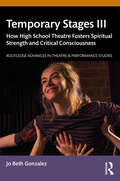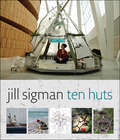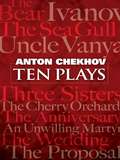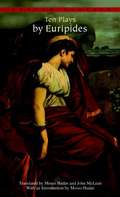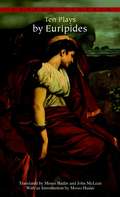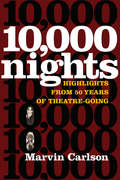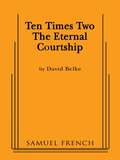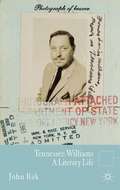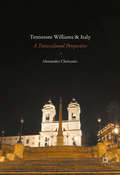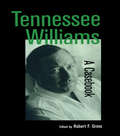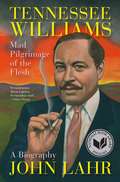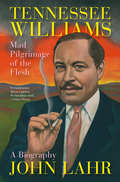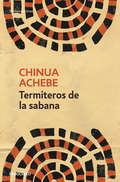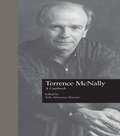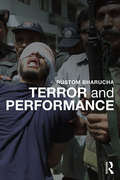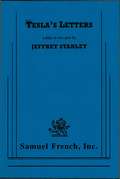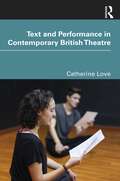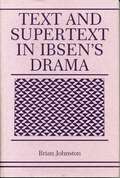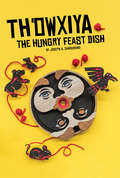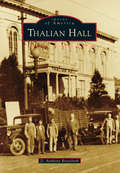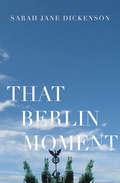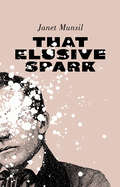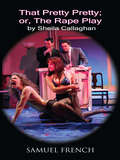- Table View
- List View
Temporary Stages III: How High School Theatre Fosters Spiritual Strength and Critical Consciousness (Routledge Advances in Theatre & Performance Studies)
by Jo Beth GonzalezTheatre activities ask adolescents to empathize with those who are different from themselves. Recognizing divergence invites self-reflection and kindles compassion. These actions tap students’ inner cores while at the same time deepening their understanding of privilege, a key component of critical consciousness.Through the lens of critical pedagogy and feminist theory, this book explores the mutually reinforcing development of spirituality and emerging critical consciousness fostered by high school theatre experience. By examining her own public high school theatre program through description, analysis and interpretation, Gonzalez explores why and how theatre work can simultaneously fortify teens’ spiritual growth while activating dawning awareness of the socio-political dynamics in their own lives and the world around them. The book includes the original one-act play Free to Fly, which introduces young people to the dangers of sex trafficking of minors.Temporary Stages III will appeal especially to secondary theatre teachers, theatre education pre-service teachers, and graduate students studying theatre pedagogy and critical cultural theory.
Ten Huts
by Jill SigmanDescribed as an artist of “prodigious imagination and intelligence” by the New York Times, Jill Sigman makes art at the intersection of dance, visual art, and social practice. An artist’s book that explores the ability of art to engage us and re-envision our environment, Ten Huts documents a series of site-specific huts that were hand built from found and repurposed materials ranging from the mundane (e-waste and plastic bottles) to the bizarre (circus detritus, dental molds, and mugwort grown on the banks of a toxic creek) in landscapes as varied as industrial Brooklyn and the Norwegian Arctic. Each of the extraordinary huts in this full-color book is a structure, a sculpture, and an emergency preparedness kit that raises questions about sustainability, shelter, real estate, and our future on this planet. Ten Huts features an artist essay by Jill Sigman and 499 illustrations, along with essays about The Hut Project by Thomas Hylland Eriksen (anthropology), André Lepecki (performance studies), Matthew McLendon (art history), Elise Springer (philosophy), and Eva Yaa Asantewaa (dance). Also includes a foreword by Pamela Tatge.
Ten Plays
by Anton ChekhovHere in one compact and modestly priced edition are the celebrated Russian playwright's most popular works. In addition to five full-length plays--The Sea Gull, Uncle Vanya, The Three Sisters, The Cherry Orchard, and Ivanov--this anthology features five of Anton Chekhov's one-act comedies: The Anniversary, An Unwilling Martyr, The Wedding, The Bear, and The Proposal.Chekhov's taste for vaudeville shows and French farces influenced his comic one-acts, which are widely regarded as masterpieces of the genre. His greatest fame rests upon his full-length tragedies, which focus on mood and characterization rather than plot. Chekhov considered his famous tragedies a form of comic satire--with the bleakness of life in czarist Russia at the turn of the twentieth century as their central joke. "All I wanted was to say honestly to people: 'Have a look at yourselves and see how bad and dreary your lives are!'" explained the playwright. In addition to their enduring emotional and intellectual appeal to audiences, Chekhov's modern realist dramas continue to influence theatrical literature and performance.
Ten Plays
by Moses Hadas Euripides John McleanThe first playwright of democracy, Euripides wrote with enduring insight and biting satire about social and political problems of Athenian life. In contrast to his contemporaries, he brought an exciting--and, to the Greeks, a stunning--realism to the "pure and noble form" of tragedy. For the first time in history, heroes and heroines on the stage were not idealized: as Sophocles himself said, Euripides shows people not as they ought to be, but as they actually are.
Ten Plays by Euripides
by EuripidesThe first playwright of democracy, Euripides wrote with enduring insight and biting satire about social and political problems of Athenian life. In contrast to his contemporaries, he brought an exciting--and, to the Greeks, a stunning--realism to the "pure and noble form" of tragedy. For the first time in history, heroes and heroines on the stage were not idealized: as Sophocles himself said, Euripides shows people not as they ought to be, but as they actually are.
Ten Thousand Nights: Highlights from 50 Years of Theatre-Going
by Marvin CarlsonEsteemed scholar and theater aficionado Marvin Carlson has seen an unsurpassed number of theatrical productions in his long and distinguished career. Ten Thousand Nights is a lively chronicle of a half-century of theatre-going, in which Carlson recalls one memorable production for each year from 1960 to 2010. These are not conventional reviews, but essays using each theater experience to provide an insight into the theater and theatre-going at a particular time. The range of performances covered is broad, from edgy experimental fare to mainstream musicals, most of them based in New York but with stops at major theater events in Paris, Berlin, Moscow, Milan, and elsewhere. The engagingly written pieces convey a vivid sense not only of each production but also of the particular venue, neighborhood, and cultural context, covering nearly all significant movements, theater artists, and groups of the late twentieth century.
Ten Times Two: The Eternal Courtship
by David BelkeFull Length / Romantic Comedy / 2m, 1f / Interior An epic romantic comedy. When Ephraim, an evildoer cursed with immortality, bets he can win the love of a barmaid in 1399 it launches a romantic pursuit spanning the centuries from the Middle Ages to Modern Times. Under the watchful eye of a mysterious Host the couple meets every seventy-five years as Ephraim schemes to capture the heart of his quarry who reincarnates as a dizzying array of different women through the years. But in order to win love the villain must eventually learn to become a human being.
Tennessee Williams
by John S. BakPerfect for students of English Literature, Theatre Studies and American Studies at college and university, The Theatre of Tennessee Williams provides a lucid and stimulating analysis of Willams' dramatic work by one of America's leading scholars. With the centennial of his birth celebrated amid a flurry of conferences devoted to his work in 2011, and his plays a central part of any literature and drama curriculum and uibiquitous in theatre repertoires, he remains a giant of twentieth century literature and drama. In Brenda Murphy's major study of his work she examines his life and career and provides an analysis of more than a score of his key plays, including in-depth studies of major works such as A Streetcar Named Desire, The Glass Menagerie, Cat on a Hot Tin Roof and others. She traces the artist figure who features in many of Williams' plays to broaden the discussion beyond the normal reference points. As with other volumes in Methuen Drama's Critical Companions series, this book features too essays by Bruce McConachie, John S. Bak, Felicia Hardison Londr#65533; and Annette Saddik, offering perspectives on different aspects of Williams' work that will assist students in their own critical thinking.
Tennessee Williams and Italy
by Alessandro ClericuzioThis book reveals for the first time the import of a hugenetwork of connections between Tennessee Williams and the country closest to his heart, Italy. America's most thought-provoking playwright loved Italy morethan any other country outside the U. S. and was deeply influenced by itsculture for most of his life. Anna Magnani's film roles in the 1940s, ItalianNeo-realist cinema, the theatre of Eduardo De Filippo, as well as the actualexperience of Italian life and culture during his long stays in the countrywere some of the elements shaping his literary output. Through his lover FrankMerlo, he also had first-hand knowledge of Italian-American life in Brooklyn. Tracing the establishment of his reputation with theItalian intelligentsia, as well as with theatre practitioners and withgenerations of audiences, the book also tells the story of a momentouscollaboration in the theatre, between Williams and Luchino Visconti, who had todefy the unceasing control Italian censorship exerted on Williams for decades.
Tennessee Williams and the Theatre of Excess
by Annette J. SaddikThe plays of Tennessee Williams' post-1961 period have often been misunderstood and dismissed. In light of Williams' centennial in 2011, which was marked internationally by productions and world premieres of his late plays, Annette J. Saddik's new reading of these works illuminates them in the context of what she terms a 'theatre of excess', which seeks liberation through exaggeration, chaos, ambiguity, and laughter. Saddik explains why they are now gaining increasing acclaim, and analyzes recent productions that successfully captured elements central to Williams' late aesthetic, particularly a delicate balance of laughter and horror with a self-consciously ironic acting style. Grounding the plays through the work of Bakhtin, Artaud, and Kristeva, as well as through the carnivalesque, the grotesque, and psychoanalytic, feminist, and queer theory, Saddik demonstrates how Williams engaged the freedom of exaggeration and excess in celebration of what he called 'the strange, the crazed, the queer'.
Tennessee Williams: A Casebook
by Robert F. GrossTennessee Williams' plays are performed around the world, and are staples of the standard American repertory. His famous portrayals of women engage feminist critics, and as America's leading gay playwright from the repressive postwar period, through Stonewall, to the growth of gay liberation, he represents an important and controversial figure for queer theorists. Gross and his contributors have included all of his plays, a chronology, introduction and bibliography.
Tennessee Williams: Mad Pilgrimage of the Flesh
by John LahrJohn Lahr has produced a theater biography like no other. Tennessee Williams: Mad Pilgrimage of the Flesh gives intimate access to the mind of one of the most brilliant dramatists of his century, whose plays reshaped the American theater and the nation's sense of itself. This astute, deeply researched biography sheds a light on Tennessee Williams's warring family, his guilt, his creative triumphs and failures, his sexuality and numerous affairs, his misreported death, even the shenanigans surrounding his estate. With vivid cameos of the formative influences in Williams's life--his fierce, belittling father Cornelius; his puritanical, domineering mother Edwina; his demented sister Rose, who was lobotomized at the age of thirty-three; his beloved grandfather, the Reverend Walter Dakin--this book is as much a biography of the man who created A Streetcar Named Desire, The Glass Menagerie, and Cat on a Hot Tin Roof as it is a trenchant exploration of Williams's plays and the tortured process of bringing them to stage and screen. The portrait of Williams himself is unforgettable: a virgin until he was twenty-six, he had serial homosexual affairs thereafter as well as long-time, bruising relationships with Pancho Gonzalez and Frank Merlo. With compassion and verve, Lahr explores how Williams's relationships informed his work and how the resulting success brought turmoil to his personal life. Lahr captures not just Williams's tempestuous public persona but also his backstage life, where his agent Audrey Wood and the director Elia Kazan play major roles, and Marlon Brando, Anna Magnani, Bette Davis, Maureen Stapleton, Diana Barrymore, and Tallulah Bankhead have scintillating walk-on parts. This is a biography of the highest order: a book about the major American playwright of his time written by the major American drama critic of his time.
Tennessee Williams: Mad Pilgrimage of the Flesh
by John LahrWinner of the National Book Critics Circle Award in Biography and Finalist for the National Book Award. The definitive biography of America's greatest playwright from the celebrated drama critic of The New Yorker. John Lahr has produced a theater biography like no other. Tennessee Williams: Mad Pilgrimage of the Flesh gives intimate access to the mind of one of the most brilliant dramatists of his century, whose plays reshaped the American theater and the nation's sense of itself. This astute, deeply researched biography sheds a light on Tennessee Williams's warring family, his guilt, his creative triumphs and failures, his sexuality and numerous affairs, his misreported death, even the shenanigans surrounding his estate. With vivid cameos of the formative influences in Williams's life--his fierce, belittling father Cornelius; his puritanical, domineering mother Edwina; his demented sister Rose, who was lobotomized at the age of thirty-three; his beloved grandfather, the Reverend Walter Dakin--Tennessee Williams: Mad Pilgrimage of the Flesh is as much a biography of the man who created A Streetcar Named Desire, The Glass Menagerie, and Cat on a Hot Tin Roof as it is a trenchant exploration of Williams's plays and the tortured process of bringing them to stage and screen. The portrait of Williams himself is unforgettable: a virgin until he was twenty-six, he had serial homosexual affairs thereafter as well as long-time, bruising relationships with Pancho Gonzalez and Frank Merlo. With compassion and verve, Lahr explores how Williams's relationships informed his work and how the resulting success brought turmoil to his personal life. Lahr captures not just Williams's tempestuous public persona but also his backstage life, where his agent Audrey Wood and the director Elia Kazan play major roles, and Marlon Brando, Anna Magnani, Bette Davis, Maureen Stapleton, Diana Barrymore, and Tallulah Bankhead have scintillating walk-on parts. This is a biography of the highest order: a book about the major American playwright of his time written by the major American drama critic of his time. Winner of the 2015 Sheridan Morley Prize for Theatre Biography American Academy of Arts and Letters' Harold D. Vursell Memorial Award Chicago Tribune Best Books of 2014 USA Today 10 Books We Loved Reading Washington Post 10 Best Books of 2014
Terence
by Sander M. GoldbergTerence's Hecyra raises social, literary and theatrical issues of great interest to modern students of Roman comedy and, indeed, of Roman culture more broadly. The play pays strikingly close attention to the domestic problems of women and experiments boldly with traditional comic forms, not only in its creation of anticipatory suspense, but through its variations on traditional situations and roles and its metatheatrical qualities. In addition, Terence's response in his prologues to the play's two putative failures is important, if tendentious, evidence for the mechanics of theatrical performance in the second century, especially the conjunction of theatrical and gladiatorial shows. This edition opens the play's many interpretive challenges to wider scrutiny while remaining attentive to the linguistic needs of students at all levels.
Termiteros de la sabana
by Chinua AchebeChris, Ikem y Beatrice son tres estudiantes que comparten opiniones políticas y tratan de sobrevivir bajo la dictadura de un presidente educado en una academia militar británica. Unidos por la lucha contra la tiranía, la relación entre los tres jóvenes da un giro radical cuando cambia el régimen político y Chris y Beatrice pasan a trabajar para el gobierno, mientras que Ikem se convierte en redactor de un periódico opositor. Pero en un mundo en que cada nuevo día conlleva una nueva traición, Beatrice se niega a rendirse y a renunciar a la esperanza.«Un libro sabio, estimulante y necesario, un poderoso antídoto a los comentaristas cínicos que, desde la otra orilla, jamás ven que salga nada nuevo de África.»Financial Times
Terrence McNally: A Casebook (Casebooks on Modern Dramatists #No. 22)
by Toby Silverman ZinmanFirst Published in 1997. Routledge is an imprint of Taylor & Francis, an informa company.
Terror and Performance
by Rustom Bharucha‘This work goes where other books fear to tread. It reaches the parts other scholars might imagine in their dreams but would neither have the international reach nor the critical acumen and forensic flourish to deliver.’ Alan Read, King's College London ‘This book is not only timely. It is overdue – and it is a masterpiece unrivalled by any book I know of.’ Erika Fischer-Lichte, Freie Universität Berlin ‘The first and only book that focuses on the intersections of performance, terror and terrorism as played out beyond a Euro-American context post-9/11. It is an important work, both substantively and methodologically.’ Jenny Hughes, University of Manchester ‘A profound and tightly bound sequence of reflections … a rigorously provocative book.’ Stephen Barber, Kingston University London In this exceptional investigation Rustom Bharucha considers the realities of Islamophobia, the legacies of Truth and Reconciliation, the deadly certitudes of State-controlled security systems and the legitimacy of counter-terror terrorism, drawing on a vast spectrum of human cruelties across the global South. The outcome is a brilliantly argued case for seeing terror as a volatile and mutant phenomenon that is deeply lived, experienced, and performed within the cultures of everyday life.
Tesla's Letters
by Jeffrey StanleyDrama / 2m, 2f / Tesla's Letters is a drama of ideas about war and peace, the exercise of humanity and the uses of science. Daisy Archer, an American doctoral candidate arrives at the Nikola Tesla Museum in Belgrade to examine its archives for her dissertation on the great scientist's life. She is not prepared for the museum's director, a Serb with family in Croatia, who probes her knowledge of Yugoslav history and of Tesla, the Croatian born Serbian genius who immigrated to the United States in 1884 and gave the world alternating electric current, wireless electric transmission and, perhaps, a death ray capable of inflicting instantaneous death. He also tests her willingness to risk her life and American innocence by entering Croatia to gather photographic evidence in Tesla's birthplace.
Text and Performance in Contemporary British Theatre
by Catherine LoveText and Performance in Contemporary British Theatre interrogates the paradoxical nature of theatre texts, which have been understood both as separate literary objects in their own right and as material for performance. Drawing on analysis of contemporary practitioners who are working creatively with text, the book re-examines the relationship between text and performance within the specific context of British theatre. The chapters discuss a wide range of theatre-makers creating work in the UK from the 1990s onwards, from playwrights like Tim Crouch and Jasmine Lee-Jones to companies including Action Hero and RashDash. In doing so, the book addresses issues such as theatrical authorship, artistic intention, and the apparent incompleteness of plays as both written and performed phenomena. Text and Performance in Contemporary British Theatre also explores the implications of changing technologies of page and stage, analysing the impact of recent developments in theatre-making, editing, and publishing on the status of the theatre text. Written for scholars, students, and practitioners alike, Text and Performance in Contemporary British Theatre provides an original perspective on one of the most enduring problems to occupy theatre practice and scholarship.
Text and Supertext in Ibsen’s Drama (G - Reference, Information and Interdisciplinary Subjects)
by Brian JohnstonBrian Johnston's approach to Ibsen, now well known, is unlike any other. Johnston sees Ibsen's twelve realist plays as a single cyclical work, the "realist" method of which hides a much larger poetic intention than has previously been suspected. He believes that the cycle constitutes one of the major works of the European imagination, comparable in scale to Goethe or Dante. And he has shown Ibsen to be the heir to Romantic and Hegelian art and thought, adapting this heritage to the circumstances of his own day.This work demonstrates how the language and scene, characters and "props," of the Ibsen dramas establish a bold and far-reaching theatrical goal: nothing less than an account of our biological and cultural identity in its multilayered totality. Johnston argues that Ibsen's realist text, while stimulating the appearance of nineteenth-century life, also objectively and precisely builds up an alternative image in which archetypal figures and situations from our cultural past repossess the realist stage. Thus he sees the Ibsen "strategy" in his realist plays as twofold: (1) the dialectical subversion of the nineteenth-century reality presented in the plays, and (2) the forced recovery of the archetypal from the past, in a procedure similar to James Joyce's in Ulysses. By "supertext" Johnston means a reservoir of cultural reference upon which Ibsen continuously drew in his realist work just as in is earlier poetic and historical dramas.
Th'owxiya: The Hungry Feast Dish
by Joseph A. DandurandWhen you take something from the earth you must always give something back. From the Kwantlen First Nation village of Squa’lets comes the tale of Th’owxiya, an old and powerful spirit that inhabits a feast dish of tempting, beautiful foods from around the world. But even surrounded by this delicious food, Th’owxiya herself craves only the taste of children. When she catches a hungry mouse named Kw’at’el stealing a piece of cheese from her dish, she threatens to devour Kw’at’el’s whole family, unless he can bring Th’owxiya two child spirits. Ignorant but desperate, Kw’at’el sets out on an epic journey to fulfill the spirit’s demands. With the help of Sqeweqs, two Spa:th and Sasq’ets, Kw’at’el endeavours to find gifts that would appease Th’owxiya and save his family. Similar to “Hansel and Gretel” and the northwest First Nations stories about the Wild Woman of the Woods, Th’owxiya—which integrates masks, song and dance—is a tale of understanding boundaries, being responsible for one’s actions, forgiving mistakes and finding the courage to stand up for what’s right.
Thalian Hall
by D. Anthony RivenbarkThalian Hall is one of the oldest and most beautiful theaters in America. Forming the east wing of Wilmington's iconic city hall, this dual-purpose building has been at the center of the community's cultural and political life since it first opened in 1858. Thalian Hall is the only surviving theater designed by John Montague Trimble, one of America's foremost 19th-century theater architects. It was built at a time when Wilmington was the largest city in North Carolina. Thalian Hall is the embodiment of a tradition of performance that stretches back for over two centuries. It has hosted Shakespearean tragedies, musical concerts, and even boxing and wrestling events. For generations, Wilmington audiences have witnessed touring stars, local actors, musicians, dancers, and movies in a parade of performances and celebratory events. The story of Thalian Hall is an embroidered tapestry reflecting the history of the American theater and the community that built it.
That Berlin Moment
by Sarah Jane DickensonBold, challenging and compelling That Berlin Moment is a play for four adult characters, two female and two male, which explores how memory is more about the present and the future than the past. 'Why don't I feel husband? I look at you and I don't feel husband, I smell you and I don't smell husband, I look at you and I -' A tragic accident has robbed Alex of her memory. Her attentive husband is eager to fill the gaps for her. But the more he tells her the more she hates who he tells her she is. Determined not to remember at all costs and with the help of a young doctor with a head full of maverick theories and a very new stethoscope, she agrees to meet the mysterious fellow patient, Stranger. Together they begin to explore and enjoy the present, but it soon becomes clear that his memories won't stay forgotten with terrifying consequences for both them and the Doctor.
That Elusive Spark
by Janet MunsilNeuropsychologist Helen Harlow is an expert at understanding the functions of the human brain, and yet her own remains a mystery. Turning her back on a once-brilliant future filled with scientific promise, Helen attempts to escape the mess of her life by diving headfirst into a new one: living in a frat-house basement, teaching Psych 101 to clueless freshmen, and confronting both her depression and the puzzling attentions of her slacker housemate Finlay. Pushed to the brink and increasingly desperate for some semblance of normalcy, Helen finds herself in a doctor's office looking for a change. But not everyone chooses to change. Certainly not Phineas Gage, a construction foreman in 1848 who miraculously survives an explosion that shoots an iron rod though his head. While Phineas makes an extraordinary physical recovery, he has a dramatic change in personality. Attended to and observed by the young doctor James Harlow, Helen's ancestor, the legacy of Phineas's dramatic story shows how far we have come scientifically, and yet how little we can comprehend of the mystery of our own hearts and minds.
That Pretty Pretty; Or, The Rape Play
by Sheila CallaghanComedy / Characters: 2m, 3f A pair of radical feminist ex-strippers scour the country on a murderous rampage against right-wing pro-lifers, blogging about their exploits in gruesome detail. Meanwhile, a scruffy screenwriter named Owen tries to bang out his magnum opus in a hotel room as his best friend Rodney ("The Rod") holds forth on rape and other manly enterprises. When Owen decides to incorporate the strippers into his screenplay, the boundaries of reality begin to blur, and only a visit from Jane Fonda can help keep worlds from blowing apart. Sheila Callaghan's That Pretty Pretty; or, The Rape Play is a violently funny and disturbing excavation of the dirty corners of our imaginations. "Mind-blowing images and soul-crushing language flowing wildly." -Back Stage "A submersion in the anarchy of ambivalence: variously a rant, a riff, a rumble - about our notions of naturalism, objectification, perversity, and beauty ... There's sass and sarcasm in Callaghan's high-energy punk writing." -John Lahr, The New Yorker "Raunchy, savvy... the twisted, caffeinated world of the show imagines the collective subconscious of a culture where girls never stiop going wild... [Callaghan] push(es) her audience's buttons with an aggressive treatment of some of the darker corners of the human psyche." -The New York Times
